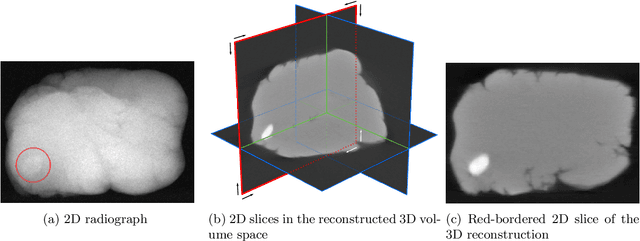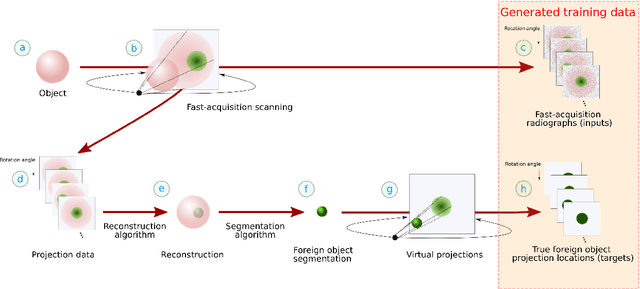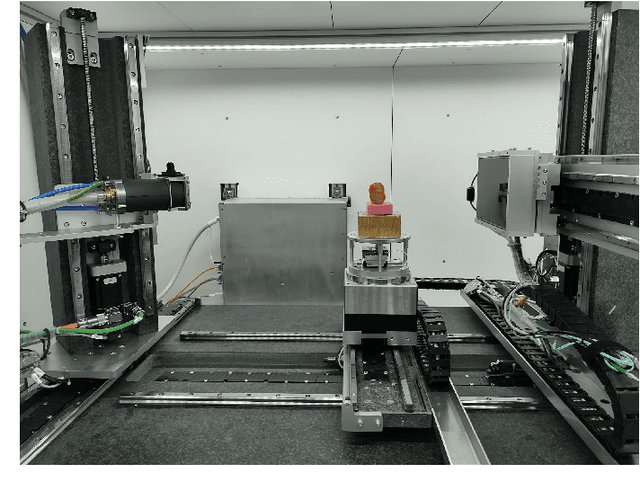Sophia Bethany Coban
A tomographic workflow to enable deep learning for X-ray based foreign object detection
Jan 28, 2022



Abstract:Detection of unwanted (`foreign') objects within products is a common procedure in many branches of industry for maintaining production quality. X-ray imaging is a fast, non-invasive and widely applicable method for foreign object detection. Deep learning has recently emerged as a powerful approach for recognizing patterns in radiographs (i.e., X-ray images), enabling automated X-ray based foreign object detection. However, these methods require a large number of training examples and manual annotation of these examples is a subjective and laborious task. In this work, we propose a Computed Tomography (CT) based method for producing training data for supervised learning of foreign object detection, with minimal labour requirements. In our approach, a few representative objects are CT scanned and reconstructed in 3D. The radiographs that have been acquired as part of the CT-scan data serve as input for the machine learning method. High-quality ground truth locations of the foreign objects are obtained through accurate 3D reconstructions and segmentations. Using these segmented volumes, corresponding 2D segmentations are obtained by creating virtual projections. We outline the benefits of objectively and reproducibly generating training data in this way compared to conventional radiograph annotation. In addition, we show how the accuracy depends on the number of objects used for the CT reconstructions. The results show that in this workflow generally only a relatively small number of representative objects (i.e., fewer than 10) are needed to achieve adequate detection performance in an industrial setting. Moreover, for real experimental data we show that the workflow leads to higher foreign object detection accuracies than with standard radiograph annotation.
Parallel-beam X-ray CT datasets of apples with internal defects and label balancing for machine learning
Dec 24, 2020



Abstract:We present three parallel-beam tomographic datasets of 94 apples with internal defects along with defect label files. The datasets are prepared for development and testing of data-driven, learning-based image reconstruction, segmentation and post-processing methods. The three versions are a noiseless simulation; simulation with added Gaussian noise, and with scattering noise. The datasets are based on real 3D X-ray CT data and their subsequent volume reconstructions. The ground truth images, based on the volume reconstructions, are also available through this project. Apples contain various defects, which naturally introduce a label bias. We tackle this by formulating the bias as an optimization problem. In addition, we demonstrate solving this problem with two methods: a simple heuristic algorithm and through mixed integer quadratic programming. This ensures the datasets can be split into test, training or validation subsets with the label bias eliminated. Therefore the datasets can be used for image reconstruction, segmentation, automatic defect detection, and testing the effects of (as well as applying new methodologies for removing) label bias in machine learning.
A Cone-Beam X-Ray CT Data Collection Designed for Machine Learning
May 12, 2019



Abstract:Unlike previous works, this open data collection consists of X-ray cone-beam (CB) computed tomography (CT) datasets specifically designed for machine learning applications and high cone-angle artefact reduction. Forty-two walnuts were scanned with a laboratory X-ray set-up to provide not only data from a single object but from a class of objects with natural variability. For each walnut, CB projections on three different source orbits were acquired to provide CB data with different cone angles as well as being able to compute artefact-free, high-quality ground truth images from the combined data that can be used for supervised learning. We provide the complete image reconstruction pipeline: raw projection data, a description of the scanning geometry, pre-processing and reconstruction scripts using open software, and the reconstructed volumes. Due to this, the dataset can not only be used for high cone-angle artefact reduction but also for algorithm development and evaluation for other tasks, such as image reconstruction from limited or sparse-angle (low-dose) scanning, super resolution, or segmentation.
 Add to Chrome
Add to Chrome Add to Firefox
Add to Firefox Add to Edge
Add to Edge